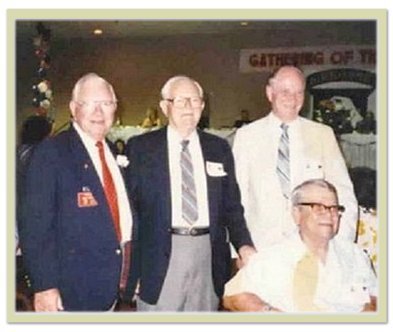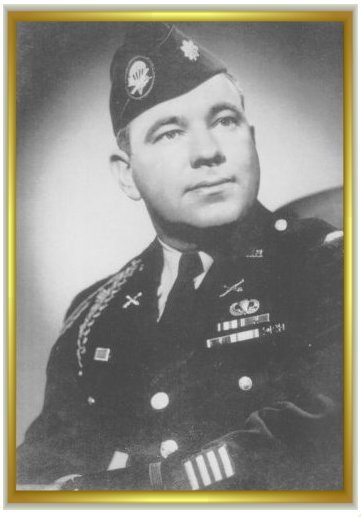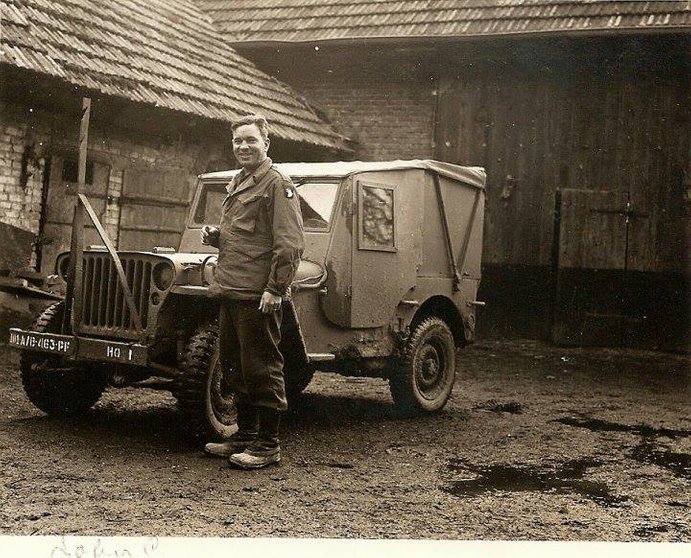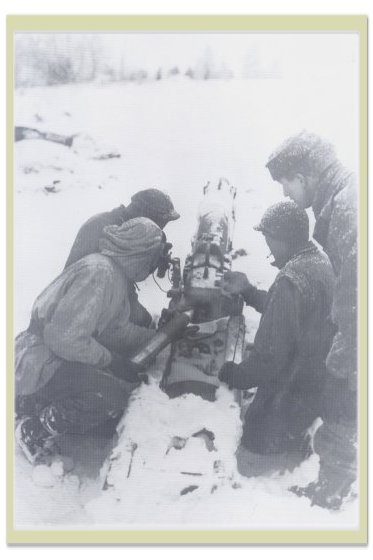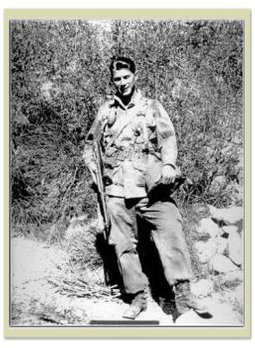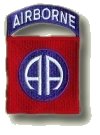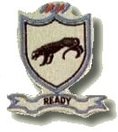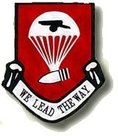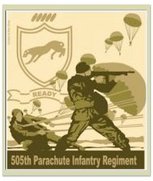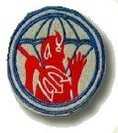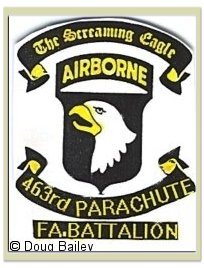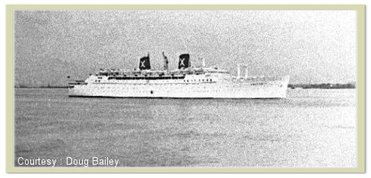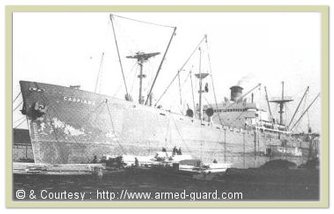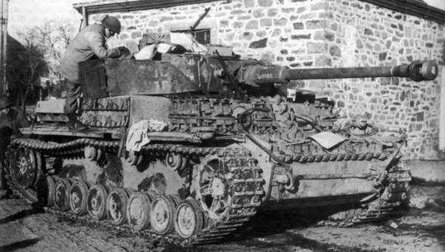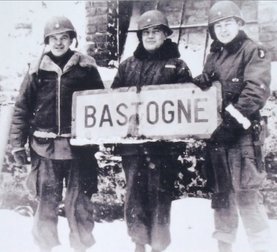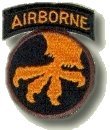The History of the Battalion
The following historical summary of the participation of the 463rd Parachute Field Artillery Battalion in World War II is written by Ken Hesler (thank you Ken !), Btry. D, 463 PFA, shown at left in Paris in January 1945 shortly after the battle at Bastogne.
It is based upon more than 2,000 pages of documents copied from the U.S. Military archives at Suitland, MD, and other historical materials, mostly documents and personal interviews with members of the battalion, including Lt. Col. John T. Cooper (Ret.), who read the article and concurred in its accuracy.
The 463rd Parachute Field Artillery Battalion was organized on February 21, 1944, near the small Italian village of Borgo Bainsizza on the Anzio beachhead. It was formed from the 82nd Airborne Division’s 456th Parachute Field Artillery Battalion, less Batteries “C” and “D”, and commanded by Maj. Hugh Neal, the first of only three men to lead the battalion in combat in World War II. The 456th designation was transferred with the 82nd to the European Theater.
In the photograph at right, taken at the 1988 101st Airborne Division Reunion in Omaha, NE, are the three men who served as commander of the battalion: standing from left, John Cooper, Hugh Neal, and Stuart Seaton. Seated is Vic Garrett, the battalion S-3, who was responsible for directing fire missions.
Officer and men of the newly organized unit were vets of the 82nd drop into Sicily in July 1943, campaigns on the southern Italian front near Casino, and weeks of bitter fighting at Anzio in support of the First Special Service Force along the Mussolini Canal. Many had been members of the Army’s original Parachute Field Artillery Test Battalion.
With its new designation, the battalion remained in support of the FSSF which, in early June 1944, led the Allied Forces into Rome. A marble plaque in that city commemorates the FSSF accomplishment, noting the assistance of “the armored units of Task Force Howze, 463rd Parachute Field Artillery Battalion, and the Italian Resistance…”
The battalion commander now was Maj. John T. Cooper, Jr., formerly the executive officer, who has assumed command when Maj. Neal was seriously wounded and evacuated form Anzio on May 31.
Lt. Col. John T. Cooper Jr.
(thanks to Ms. C. (Cooper) Baker, his daughter, for the picture)
After the fall of Rome, the battalion received some 200 replacements to fill out “C” and “D” batteries and bring its rosters to full fighting strength. A month later, the battalion was on its way to the invasion of Southern France with the First Airborne Task Force as part of a combat team with the 509th Parachute Parachute Infantry Regiment. Divided to operate as two separate units, if necessary, the battalion flew from loading zones at Grosseta and Follonica airports near Rome.
In the early morning hours of August 15, one group under the command of Major Stuart M, Seaton, the battalion executive officer, jumped near Le Muy, France. The second contingent under Cooper's command were dropped across a wide area around St. Tropez, France, some 12 miles from the drop zone, where they fought as infantry against heavy German concentrations. Cooper was injured in the drop; and the third person to command the unit, Maj. Stuart Seaton, the executive officer, served as battalion commander until Cooper returned October 14.
The Battalion was credited with capturing 375 prisoners during the first two days of the invasion, more than the remainder of the entire Task force over the same period. As the seaborne invasion troops drove inland, the 463rd moved eastward along the coast until on August 30, 1944, when it was shifted northward to the Alps and attached to the 55Oth Airborne lnfantry. Its mission was to cutoff an important German escape route from Italy.
The mountain campaign, which found the battalion spread along a 12-mile front, included a blizzard which buried the guns of Btry “A" under eight feet of snow at an altitude of 10,000 feet and a late evening German attack in mid-October which was repulsed with 5,600 rounds of direct fire. On October 22, the battalion moved into position along the French-Italian border near the coast, again in support of the First Special Service Force.
In mid-November, the 463rd was relieved by the 6O2nd FA and moved into bivouac near Nice. Over the three-month period of the Southern France campaign, the battalion conducted 1,000 fire missions and fired approximately 35,000 rounds of 75mm ammunition. With the "Champagne Campaign" concluded, the 463rd moved northward by truck and train in December. Scheduled to join the 17th Airborne Division then on its way to Europe, the battalion arrived in Mourmelon, France, on December 12, 1944, where the 101st Airborne Division was recuperating from the Holland campaign. The German break through into the Ardennes came just four days later. The Battle of the Bulge had begun.
As the 101st prepared to depart for Belgium, Cooper, by now a Lieutenant Colonel, offered the services of the battalion to Gen. McAuliffe, who said the 463rd was outside his command; but he suggested that Cooper talk with Col. Joseph H. Harper, commanding the 327th Glider Infantry. Harper readily accepted Cooper's offer, and the 463rd was off to Bastogne "attached" to the 101st although technically A.W.O.L.
During most of its existence, except for the airborne drop info Southern France, the 463rd, unlike most airborne units, had been utilized as a ground-equipped unit provided with its own transportation. It had arrived in Mourmelon with 27 2 1/2-ton trucks, 26 1/4-ton trucks, and a sizable supply of 75mm ammunition, including more than 200 anti-tank rounds, a factor to be of significance at Bastogne.
Unlike some units heading for the Ardennes, it had been fully supplied with wool overcoats and "mud-pack" overshoes before leaving Southern France. With the addition of 12 2 1/2-ton trucks attached from the 645th Quartermaster Company, the 535 men of the 463rd headed north from Mourmelon at 9:30 p.m. December 18. 1944. Although the destination listed on the Unit Report dated 11 p.m. of the same date reads "now enroute to Werboment, Belgium," the 101st would instead be shifted to Bastogne, Belgium, an important road center.
At 9 a.m. on December 19, the unit reached an assembly area near Flamizoulle, Belgium, and moved on later the same day to establish positions around Hemroulle in support of the 327th. By December 20, the 101st Airborne Division, including the 463rd, was completely surrounded in the three-mile wide Bastogne "doughnut", by at least five German divisions.
The fighting was intense. On December 22, the Germans delivered a note demanding the 101st surrender, to which General Anthony McAuliffe issued his famous reply, “NUTS". With the weather clearing on December 23, C-47 transport planes dropped badly needed ammunition and supplies. Finally, on December 26, General Patton’s 4th Armored Division broke through from the south to relieve the besieged city.
During the Battle of Bastogne, the 463rd howitzers conducted fire missions over a 360- degree sector. From December 19 through January 17, its 16 howitzers fired 21,748 rounds. When the first aerial re-supply mission was flown on December 23, the battalion was down to nine rounds of high explosive shells, a small supply of anti-tank rounds, and no rations. The battalion casualty report for the Ardennes campaign was 11 killed, 24 wounded, and one missing.
During the Bulge, Lt. Col. Cooper and Sgt. Joseph F. Rogan were awarded the Silver Star. Cooper for action during the encirclement and Rogan for action as a forward observer on December 25 and 26. In addition, seven men received the Bronze Star, two posthumously. Thirty-two received the Certificate of Merit, 29 of them for action during the German attack on Christmas morning.
There is disagreement about the tank battle on Christmas morning when one spearhead of enemy tanks attacked toward Hemroulle from the west. Col. T. L. Sherburne, Jr., the Acting Field Artillery Commander of the 101st credited the battalion with two medium tanks destroyed and one captured. Cooper maintains that eight of 11 enemy tanks in the thrust at Hemroulle were destroyed by the battalion, with one captured intact and two escaping only to be destroyed by armored units. He tells the story this way:
“At the conclusion of the battle on Christmas mornings, General McAuliffe, Col. Sherburne, and others of their staff came to our headquarters and we inspected the battle area. General McAuliffe looked at each tank and asked the question. 'Which gun got this one?' Only two of the tanks were in direct line of fire as shown by ‘ricochet marks in the snow.’ The others were hit, but had been moving and were not in line of ricochet marks. Also, all direct fire does not hit the snow along its path of flight.”
“Col. Sherburne took notes and wrote the commendation as decided by Gen. McAuliffe. I did not object, as I was a new Lt. Colonel unknown to any of the brass at the time. Nor was I looking ahead to 50 years later. No other unit has ever claimed any of the Christmas morning kills in our area."
Relieved in Belgium on January 17, 1945, the 463rd moved with the 101st to the French Alsace region on January 20 and went into direct support of the 327th Glider Infantry Regiment from positions near Keffendorf and Winterhouse. The battalion was relieved by the 36th Division Artillery on February 25, and moved from Sarrebourg to Mourmelon by train and truck. It was at Mourmelon that General Dwight Eisenhower presented the 101st with the Presidential Unit Citation for its defense of Bastogne, the first such citation to be awarded an entire division. Operating as a unit attached to the 101st during the Bastogne encounter, the 463rd was formally assigned to the division in March 1945.
Remaining in Mourmelon until April 3, the battalion, still in support of the 327th, moved to the vicinity of Neuss, Germany, where it completed its last day of direct contact with the enemy at 4 p.m. April 17, 1945. It was then on to Schillingstadt, Schwabsoin, Starnberg, Thalham and Bad Reichenhall --arriving at the last on May 12. The final moves were to Saalfelden, Austria, on July 8, and Joigny, France, on August 2. Most of the remaining members of the unit were transferred for deployment and discharge in October, 1944. The 463rd was inactivated November 30, 1945.
The Unit Citation and Campaign Participation Credit Register of the U. S. Department of the Army lists the following campaigns for the 463rd in World War II: Anzio, Rome-Arno, Southern France, Rhineland, Ardennes-Alsace and Central Europe.
FIRE MISSION
A Condensed History Addition, by Douglas BAILEY
Doug Bailey in France
82nd Airborne
(All American)
505th PIR
patch
456th Parachute
Field Artillery
504th PIR Patch
(Devils in 'Baggy Pants')
509th PIR
Patch
Starting out as the 456th. Parachute Arty. Bn at Fort Bragg N.C. the 456th was part of the 505th Parachute Infantry Regimental Combat team in the 82nd Airborne Division.
We left Fort Bragg in April, 1943 for a twelve day trip on the Matson liner, S.S. Monterey. Landing at Casablanca, we soon headed deeper into French Morocco, close to the Algeria border to an area around the city of Oujda. At Oujda we went into training getting ready for the Sicily Jump.
This area around Oujda is probably the most fertile part of French Morocco, as the whole 82nd got dysentery at one time or another.
It was here at Oujda that most of us made our first night jump. We then flew to Tunisia up around the city of Kariouan, and camped in the hot and miserable desert for a couple of days before we loaded the C-47's for the long flight across the Mediterranean.
At left :
The S.S Britanis passing the Statue of Liberty
September 9, 1982.
She was built for Matson lines U.S. West Coast - Pacific service in 1931 as MONTEREY and was sold to the Chandris Group in 1970 and sailed into the 1990's.
She sank in the South Atlantic while enroute to the breakers.
We took-off about 8 o'clock that night and arrived over the Island of Sicily around 12:30 a.m. B-Btry Jumped with the 2nd Battalion 505th Parachute lnfantry. We came roaring in over the coast, through the anti-aircraft fire like a run away freight train.
Although we were a long way from our intended drop zone, we got the green light. Out we tumbled into the darkness, coming down right smack in the middle of a fortified position, landing in trees, rock walls, and in one case I know, on the roof of a fortified farm house. We were a long way from our drop zone, but at least B-Btry and the 2nd Bn. were altogether. We soon cleared out the area, capturing pill boxes, road blocks and fortified farm buildings, and prisoners.
That night we started out on an all night march with our prisoners headed for Gela, where the rest of the Combat team was supposed to be.
We were moving through the town of Vittoria, when we witnessed the terrific anti-aircraft fire which shot down so many planes of the 504th Parachute Combat Team coming in from Africa.
We finally caught up with part of the combat team at Biazza Ridge, where they were in the process of burying about twenty Paratroopers killed in that battle. The next day we marched to Gela where we got some truck transportation- our own and many captured ones. We then headed up the Island for Trapani.
It was here on the outskirts of Trapani that many of us remember lying in slit trenches in a grape vineyard, eating grapes and watching with some amusement, enemy air burst trying to find us. The only trouble was that they had their fuses set too short, and they were bursting far over our heads.
After Sicily was secured, we flew back to North Africa to get replacements, re-equip, and enjoy a show in the desert put on by Bob Hope. We only spent a short time in Africa and then flew back to Sicily to get ready for our next mission.
It was here that some of us made an experimental jump with the 75 Pack Howitzer all ready assembled in a glider. We flew out over the Mediterranean, turned and came in over the coast, released the Glider, then the tow rope and then we jumped, landing in a freshly plowed field on the outskirts of the Airfield.
CG-4A Glider
This picture of the Anson Jones was taken after the War and the ship renamed SS Caspania (Doug)
Within a week we were up on the Casino front. This was in December 1943, and we spent Christmas at the front up around Venefro. Little did we realize that a year later we would be spending another Christmas in the snows of Bastogne… Rain, snow, mud, mules and mountains - that's the story of the Casino front. The only place during the whole war that the ground looked like pictures of No-Mans land during the first World War with water filled shell holes, trees shattered and destroyed villages. After a few weeks on the Casino front, we pulled out and headed back to an area close to Naples. We thought we were going to get a rest.
Little did we realize that the next day we would load on Naval landing ships to be fed into the meat grinder that became the Anzio Beachhead. For four months we lived like Moles in one man slit trenched dug into the sides of the irrigation ditches. It was on Anzio we left the 456th Parachute Battalion and became the 463rd Parachute Battalion.
After 38 years, memories of Anzio all run together. The shelling and counter shelling. German Bombers over at night bombing by the light of parachute flares that lit everything like daylight, firing thousands of rounds at the enemy, firing T.O.T. missions (Time on Target) when every gun on the Beachhead would open up at the same time and pulverize the same target area, watching our own bombers being shot down as they flew overhead to bomb enemy positions, German bombers dropping radio controlled glider bombs in front of our Gun positions and then directed to hit ships in the harbor; picking up German propaganda leaflets telling us to get off the Beachhead while we still had a chance, building fox hole radios out of a carbon out of flashlight batteries, a razor blade, some wire, lead out of a wood pencil, and the crystal out of a Army Sound Power phone.
We could pick up the girl broadcaster in Rome putting out propaganda programs. We referred to her as the "Berlin Bitch".
Week after week of C & K rations, and having our Battery Commander killed, and our Battalion Commander so badly wounded that he never returned to the Battalion.
Finally, after building up supplies. getting some replacements, we broke out of the Beachhead, and with the rest of the 5th Army, headed for Rome. After Rome was captured, we were finally pulled out of combat for a well deserved rest. First at Lake Albano, and then at the beach at Lido di Roma. We enjoyed the beaches, passes to Rome, the wine, the city itself, and the glorious sunshine.
But all good things must come to an end, and we soon headed for an airfield North of Rome to get ready to lead the Invasion of Southern France as part of the First Airborne Task Force. The 463rd, along with the 509th Parachute Bn. loaded planed around midnight for another long flight across the Ligurian Sea.
We arrived over the cloud covered coast of France about 4:30 in the morning. About six plane loads of the 463rd and 509th got the jump signal too early, and out we went into the darkness to come down through the clouds to land in and around the Sea coast tow of St. Tropez. We soon captured the town and many prisoners, and later joined the rest of the Task Force up around Le Muy.
We then headed up the coast to the outskirts of Nice. On the way, the First Airborne Task Force destroyed an enemy division and forced bank other enemy forces that were better equipped and were familiar with the terrain. It was here the 463rd and a Glider Infantry battalion were pulled out and sent up to the French Alps to fight as Mountain Troops. We were up here for quite sometime. As winter was coming on and the trucks would have difficulty bringing up supplies, we were replaced by an Algerian outfit from Africa that had mules to work with. We soon headed back to the coast to join the rest of the 1st. Airborne Task Force and get our share of the Champagne campaign.
17th Airborne Patch
We would have been quite content to spend the rest of the war in this beautiful country, but the Gods of war had other plans. They broke up the 1st A/B Task Force, and soon the 463rd traveled by box cars to Mourmelon where the 101st Airborne were licking their wounds from the battles in Holland.
We were suppose to wait here for the 17th Airborne Division to come over from the States and join them, but the Germans made the big breakthrough that started the Battle of the Bulge.
Our Colonel "John T. Cooper" volunteered the 463rd. to go along with the 101st. and that's how we became a part of the 101st Airborne Division. He soon headed for Belgium, the 463rd digging in around the small village of Hemroulle.
It was here the 463rd knocked out three Mark IV Tanks by direct fire, captured one intact and drove it into our lines to be used as a roadblock. (picture at upper left)
It was at Hemroulle on the 24th of December that this writer, Doug Bailey, Don Zafke, and Cecil Farmer were wounded, eventually all of us ending up in hospitals in England. Zafke and Bailey rejoining the Battalion at Mourmelon, Farmer stayed in the Hosp. until after the war.
We were soon headed up to the Rhine, holding the west bank of the River while other forces were closing the Ruhr Pocket. We then headed south. We were in the hills about 30 miles from Munich when the war ended.
No longer would we hear the cry of " Stand up and hook up" or “Stand in the door". Never again would we get the commands of "Fire Mission, Battery adjust, Shell H.E. Charge 4, Fuse quick". We had buried our dead in Sicily, Italy, France, Belgium and Germany.
The old original bunch had come a long way from Africa to Berchtesgaden. We were entitled to 7 battle stars, 2 bronze Initial Assault Arrowheads, the Presidential Citation, two stars on our Jump wings, and lots of pleasant memories of serving with a great bunch of men who for their own personal reasons decided to go Airborne.
Douglas M. Bailey
Port Angeles, WA 98362
A Condensed Chronology, by Martin GRAHAM
Based in large part on a collection of archival documents and other materials,
acquired and provided by Ken Hesler, Battery D, 463rd PFA.







